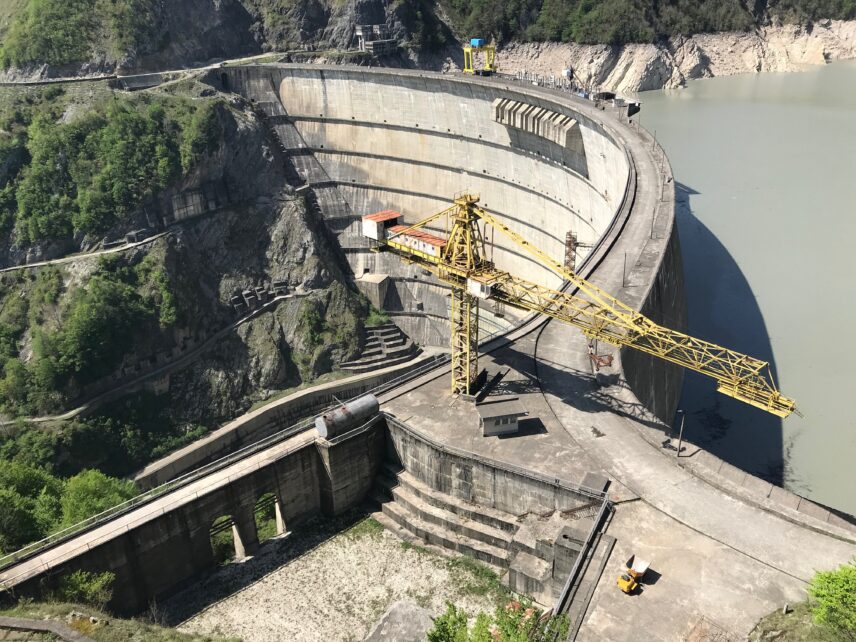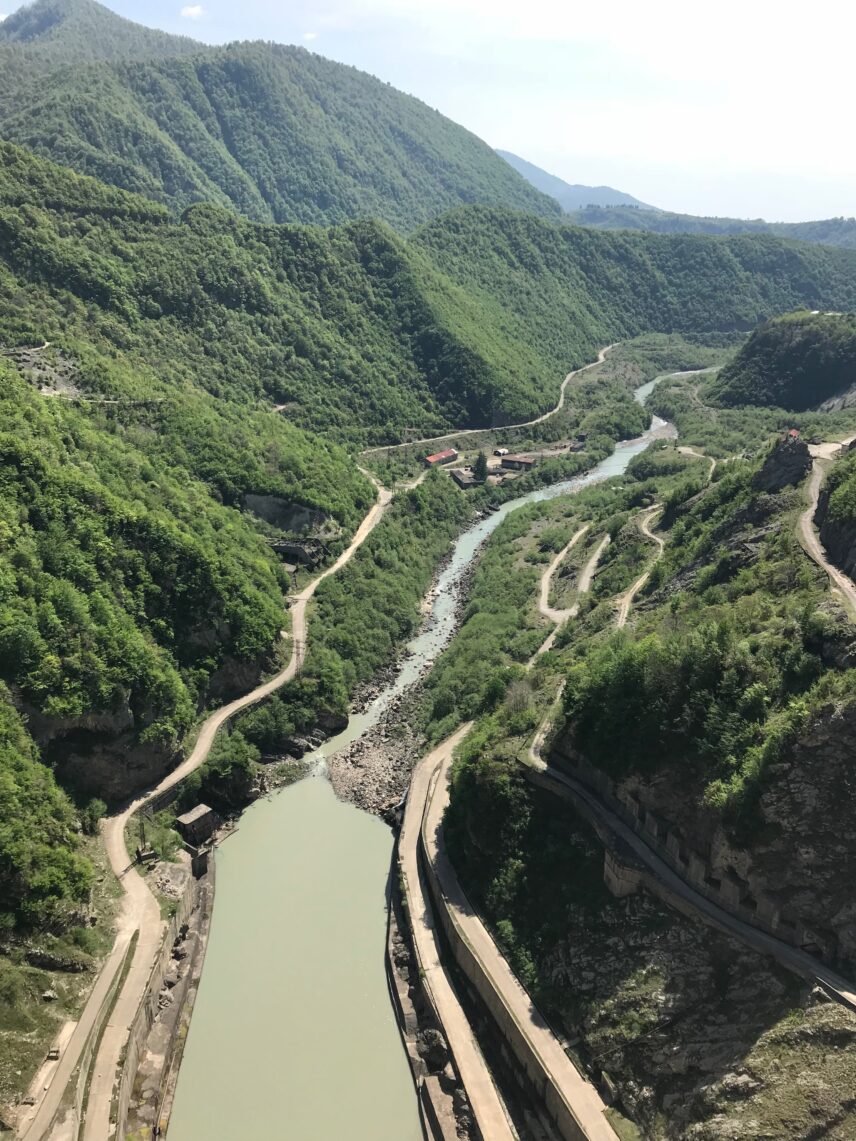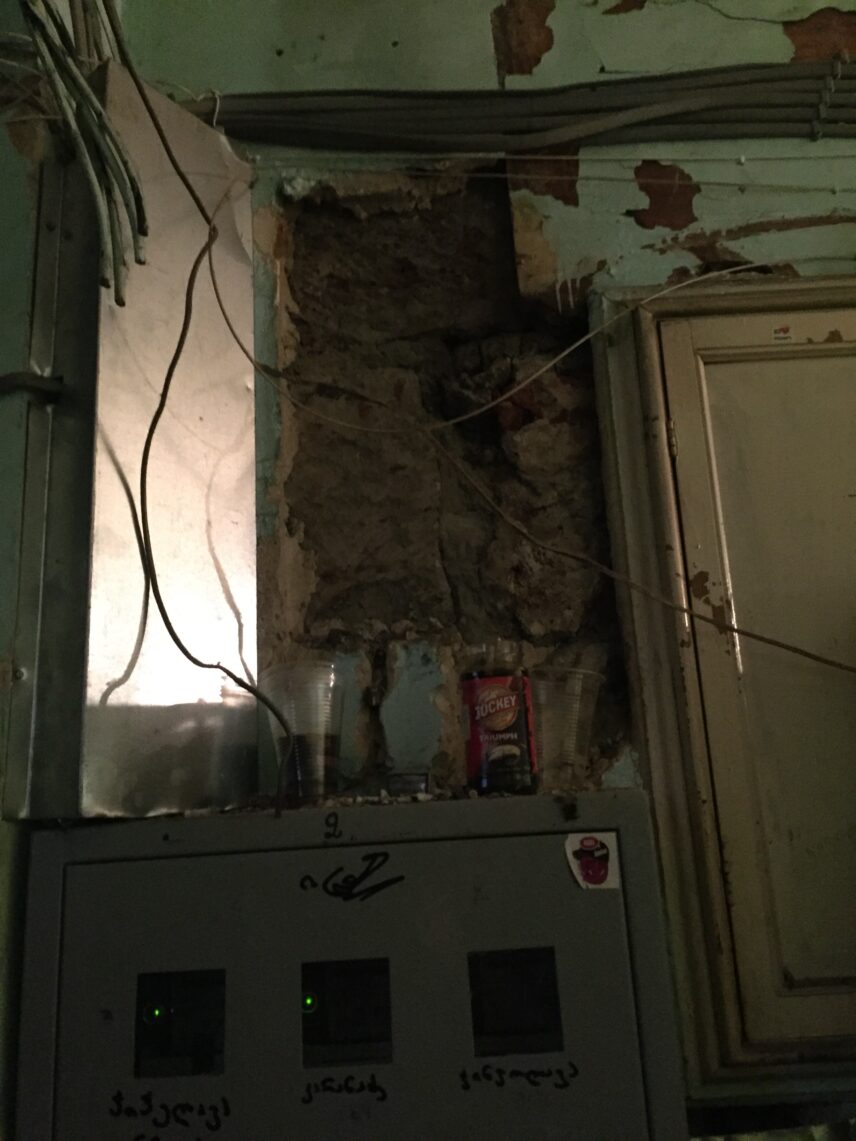Article begins
Communism is Soviet power plus the electrification of the whole country.
—Vladimir Lenin, 1921.
Creeping border, de facto state, frozen conflict—so often the social scientific lexicon for spaces of long-term conflict focuses on states and their territorial boundaries. But the disputed Georgia-Abkhazia borderland is anything but “frozen.” It is animated by the continuous movement of people and objects, rapid changes in topography, and by the controversial electricity of a Soviet-era hydroelectric dam, Engurhesi, connecting the two sides of this “divided national territory.” As Engurhesi’s contentious power travels across the contested borderland and enters into private homes, the dam and its energy network generate a conflict zone, or an electric zone, powered by, charged with, and producing electricity.

Troubled waters
The headwaters of the 221-kilometer Enguri River originate with the Shkhara glacier in Svaneti region, near the highest point in Georgia along its border with Russia. Flowing from the country’s majestic mountains, the Enguri changes in form and character, shapes places and lives, and gains a disputed and eventful biography as it approaches its final destination—the Black Sea, a place the Roman poet Ovid, banished here in the first century AD, called the sea “in the back of beyond.”
Losing much of its vigor and speed in the lowlands of western Georgia, the river resigns itself to the surrounding topography, its bends and branches creating both permanent and temporary river islands. This is where the river becomes politically turbulent and divisive despite its waters widening, splitting, and calming down. This is where the river is encountered as an unrecognized, de facto border that, to use Rebecca Bryant and Mete Hatay’s words, is very much “real but not realized.”
Once marking an unmanned administrative border that people crossed freely in Soviet times, the Enguri River and its landscapes have been a zone of so-called frozen conflict for the last three decades. During the war (1992–1993) between the postsocialist Georgian state and Abkhaz forces supporting the independence of Abkhazia, which was an autonomous republic within Soviet Georgia, Georgia lost control over Abkhaz territory, and thousands of ethnic Georgians were forced to leave their homes. The conflict remains unresolved because of opposing territorial claims, and most displaced people have lost ties with Abkhazia over the years—except for a community of Georgians from the Gali district.
Separated from the rest of Georgia by an ambiguous yet militarized border, Gali experienced less destruction during the war, since ethnic Georgians constituted 96 percent of its prewar population. And so shortly after the war, Gali residents started to go back to their homes and maintained their ties with both sides of the divide. For the people of Gali, livelihoods, along with practices and imaginations of home, depend on movements that are constrained and contingent. The “Gali returnees” of policy and human rights reports did not actually “return” to Gali once and for all. Instead, they have split families, made multiple and interdependent homes, and developed tactical ways of staying and leaving on both sides to optimize their resources and chances for a better future. Despite legal and military attempts—of Georgia, Abkhazia, and the patron state Russia—to constrain their rights and mobility, the people of Gali have established mobile lives and “contingent homes” in the periphery of an unrecognized state and at the heart of an unresolved conflict.
A dam and a conflict
“When I look at this huge wall, I forget that Enguri is a border, isn’t it ironic?” Natia said without turning her gaze from the colossal concrete walls of the Engurhesi. Standing 271.5 meters high, the Enguri Dam towered above us, its structure stemming the river in Jvari, halfway along its path west to the Black Sea. “The size of it, its walls have always created both fear and wonder in me,” Natia, 30 years old and displaced from Gali as a child, eloquently explained. Tilting my head to see the point where the massive barrier meets the bright sky, I understood Natia’s feeling. The water leaking from the drainpipes and the smell of the moss covering the walls signaled the tension between the waters of the Enguri River and the dam. At that moment, it was not hard to imagine how a wall, so attached to our ideas of border-ness, could eclipse the Enguri’s divisive qualifiers, its arbitrary fences, trenches, and checkpoints. The wall inserted the river and its barely tamed fluidity into our perceptions and imaginations. A monumental reminder that the Enguri River is not merely a site of conflict and separation.
The Enguri hydroelectric complex, with an arch dam and five plants, was constructed in 1987 (in 1978 it was partially and temporarily operational) as part of the Sovietization and electrification of the whole Union, and it was centrally managed in Moscow. Like many other Soviet-era infrastructures knitting Soviet republics together into a single polity and creating vital interdependencies, the Enguri complex also spread across the administrative line separating the autonomous Abkhazia from the rest of Georgia during the Soviet Union. The electricity produced reached as far east as Kazakhstan to meet peak demand. While the dam and reservoir are located on Georgian-controlled territory, the five interconnected power plants are in Abkhazia together with the main diversion dam unit, a dam-type plant, and three similar river channel plants. From the higher elevation of the main dam in Jvari, water is rerouted through a large channel extending into Abkhaz territory for 15 kilometers.
During the war, neither side staged an attack near the facilities: Engurhesi and its power plants were too vital to destroy. As Bakuri, a Georgian technician who has been crossing the border work at the dam every day for nearly 30 years, said “Destroying Engurhesi would be like denying oxygen to a person.” As the region’s tea, porcelain, and cellulose factories were abandoned to decay or used to shelter displaced people, the Enguri facilities continued to operate even during the most violent days of the war.
The Engurhesi complex has generated a distinct field around the river, one that is perceived as transcending politics and immune to the uncertainties of the conflict. Since the war, it has offered predictability to its employees in a zone of protracted violence and precarity. Whatever the future of the conflict, Engurhesi employees think the dam will continue to work—after all, both sides need the electricity it produces. Bakuri explained that “Engurhesi reconciled people who hated each other, who could not stand being in the same room. I never think that I am working for Georgia, Abkhazia, or Russia. I work for the people… I have worked here for 30 years. I will probably live here forever. When I die, they will probably bury me here.” For people who work at the power station, the dam is outside the contours of the future that the conflict continuously disrupts; it is a place that brings opposing views and people together.
The dam not only changes the geological structure of the Enguri River but also generates relations and spatiotemporal experiences perceived to be beyond conflict dynamics. Despite the political antagonism between the two sides of the river, the dam does not recognize the border because, as filmmaker Maradia Tsaava puts it, “water has no borders.”

Electric divisions
Engurhesi’s electricity, however, becomes controversial and divisive as it enters homes through an infrastructural network that has barely endured a regime change, the war, an ongoing conflict, and lack of maintenance. Rather than the quiet, efficient ease of electricity flows in many other settings, Engurhesi’s electricity charges war-torn homes with continuous anxiety, and cross-border lives with resentment. “I hope they [people in Abkhazia] will understand now how it feels to think about electricity all the time!” Lela said on a February day in 2017 when Engurhesi was temporarily closed for structural repairs, cutting the breakaway territory’s primary source of electricity. A young woman from Gali and a recent university graduate hoping to find a job at a local public office, she spoke of electrical woes as we walked to her one-room apartment in the abandoned Soviet-era industrial town of Kombinati: “I want even my own relatives in Gali to understand how we live here. Unlike them, we pay for electricity!”
Having returned to their half-destroyed home in Gali shortly after the war, Lela’s uncle and his family use Enguri’s electricity almost for free like the rest of the population in Abkhazia. Despite losing its sovereignty over the breakaway territory, the Georgian state supplies electricity to Abkhazia, using it as a conduit to claim territorial integrity, with an informal limit of 40 percent of the Enguri Dam’s annual electricity output. But electricity use increasingly exceeds this limit, especially in winter when the majority of residents rely on electricity for heating (and, more recently, due to a bitcoin mining boom in Abkhazia). Many displaced households on the Georgian side also use electric heaters to survive the winter cold. Dilapidated Soviet buildings (such as abandoned hotels, schools, and hospitals) have become permanent homes for thousands of displaced people over the decades. They often lack proper windows and doors, let alone functioning gas infrastructure. But unlike buildings in Abkhazia, those in Georgia are equipped with one type of infrastructure that works surprisingly well: privatized electricity meters.
“I sometimes think they are like aliens watching us with red eyes,” Lela told me as we passed the meter boxes in the Soviet building where she has lived with her parents for more than 20 years. Grey electric boxes were installed on every floor, adorning cracked walls in dark corridors that residents left unlit to save on expenses. Small, numbered windows for each household blinked with red lights, tangled electric cables spilling out to wire and electrify the whole building. The flash of lights, jumbled wires, and miscellaneous furniture items filling the dim corridors of the former hospital were a reminder that nothing, not even electricity, is subtle and effortless for displaced residents. The things and imaginations of home were contained within small rooms: a piano and a China cabinet squeezed next to an ornate bed frame; a crystal decanter saved from the war. Wires required frequent repair to avoid fires and electricity was used strategically to keep bills low.
“We always say Abkhazia is backward but at least they do not need to worry about electricity; maybe life is better there,” Lela said, referring again to her uncle’s family in Gali. Like many Georgians on the Georgian side of the border, she was resentful that some returnees may have ended up with more comfortable lives in the war-torn, isolated, and militarized homeland. Electricity was one of the driving forces of this resentment. Unlike Georgia, separated Abkhazia could not develop and become “modern” enough to privatize its electrical system. There is no metering for electricity usage; residents and business owners in Abkhazia make symbolic payments to a local company that does not share revenue with Georgia. Energy demand in Abkhazia continues to grow because of extreme consumption as well as losses in transmission due its rundown local energy grid.
During the days when I listened to circulating stories of Abkhazian hotels with heated pools paying monthly electric bills of only 70 dollars, Lela was questioning her family’s decision to stay in Georgia by comparing their life conditions with those of her uncle in Gali: “I know that life is not easy there with Russian and Abkhaz guards around; but they have a nice house at least. You see how we live; we spend our days in front of a heater warming up one half of our bodies. They have electric heaters and AC in every room, their TV would not even fit into our room!” Lela knew that her portrayal of her uncle’s house was not the whole picture; she knew how many times her cousin was beaten and detained because he could not comply with the documentary requirements of the shifting border regime; she knew well that her uncle must cross a militarized border or swim across the Enguri to go to a pharmacy.
Lela’s perceptions and her resentments, however, show us that experiences of conflict are not limited to what states and borders do and how they materialize. Electric heaters, worn-out wires, and electricity meters connect and divide; the walls of a massive hydroelectric dam charge a contested territory with electricity, security, and resentment. As it does so, a decades-long conflict zone emerges as an electric zone—a shifting assemblage of infrastructures and affective energy worlds that reconfigure conflict spaces in unexpected ways.
At the hydroelectric power plant in Gali, Bakuri returns to prewar days, drinking tea with his Georgian and Abkhazian colleagues. In her small apartment, Lela sips her favorite Russian coffee and imagines living in an apartment in Tbilisi, warming herself with the electric heater.


